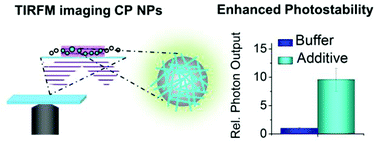Enhancing the photostability of poly(phenylene ethynylene) for single particle studies†
Abstract
Single molecule fluorescence (SMF) studies on conjugated polymers yield enhanced information on exciton dynamics and on the interplay between polymer conformation/morphology and photophysical behavior. SMF studies, however, demand good signal stability, excellent photostability, and high photon yields (a measure of both photostability and brightness) and thus the development of strategies to help conjugated polymers (CPs) meet these requirements is a topic of great interest. Here, we evaluate the effect of a number of triplet quencher additives on the photostability of a 49-mer long poly(phenylene–ethynylene) conjugated polymer bearing carboxylate side groups (PPE-CO2-49) that is deposited onto 100 nm diameter SiO2 nanoparticles (NPs). The additives tested include ascorbic acid (AA), β-mercaptoethanol (BME), Ni2+, trolox (TX), and a trolox/trolox quinone mixture (TX/TQ), used either with or without an enzymatic oxygen scavenging system (glucose oxidase/catalase, GODCAT). Total internal reflection fluorescence microscopy (TIRFM) studies enabled the determination of the effect of the additives on the rates of photobleaching, the initial intensity, and the total photon output for hundreds of conjugated polymer coated SiO2 nanoparticles monitored in parallel. Addition of the antioxidant/triplet quenchers AA and TX led to a 3–8-fold increase in the number of photons collected as well as an enhancement of the initial emission intensity, consistent with an increase in the duty cycle attributed to the quenching of triplet states. Removal of oxygen led to an impressive 10–15-fold increase in the photostability relative to buffer, implicating reactive oxygen species (ROS) as an important agent in the photodegradation of PPE-CO2-49. Combining AA and TX with GODCAT had a deleterious rather than an additive effect, suggesting that an oxidizing agent is in fact necessary to rescue the polymer from reactive intermediates formed via reaction with AA/TX. β-Mercaptoethanol and Ni2+ were not found to have useful properties toward the photostabilization of PPE-CO2-49. The results of this study provide suitable imaging conditions to conduct single molecule imaging experiments on conjugated polyelectrolytes.



 Please wait while we load your content...
Please wait while we load your content...